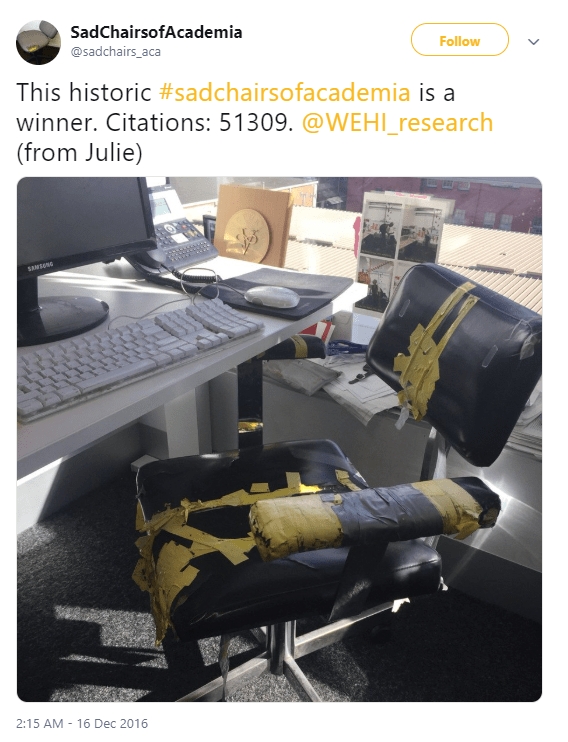This post started life as an interview. A writer from the US had approached me to talk about my #sadchairsofacademia project. This was in late 2016. The interview is still unpublished so I thought I’d rejuvenate it. Thank you to Drew Z. for getting the ball rolling.
—————————————-
What started the project?
I’ve worked in universities most of my adult life, and there’s a real contrast between the old and new faces of any institution. There’s the flagship multi-million dollar edifices that feature in all the university advertising and where international delegations are toured through, then there’s the solid, older work-horse buildings and rooms that carry the weight of the classes and staff offices.
The idea of the #sadchairsofacademia came to me when I was temporarily located in a section of a building that used to house academics who were now gone because of organisational restructuring. This process, always a traumatic one for those who go or stay, is never a clean one. The traces of the absent staff – their sticky-notes, stationery, old event flyers – were still in the offices, and the corridors had discarded furniture with piles of old books and journals stacked on them. This is the chair that brought the idea into being:

It wasn’t one of the first posted images because it was covered in old journals and books. I went back to that corridor about a year later and the poor thing was still there, without its carapace of unwanted journals and books.
What do I look for in a ‘sad chair’? What exactly makes it sad, how does a chair generate affect for me?
When I first started the tumblr in March 2015, I was just thinking it would document the sad chairs around my current institution (much like my other tumblr ‘Tired Bags of Melbourne‘ documents my 3-hour-a-day commute to my job).
For me, back then, ‘sad chairs’ were those that looked as if they’d been worn down and neglected, damaged, forgotten. There’s always a cycle of renewal for furniture, and the ones that are left behind can be an eclectic and hip/retro bunch, but they can also just be broken and abandoned. The older, worn chairs that are cast aside for newer, slicker versions are a clear metaphor for the established dominance of neoliberal dynamics within universities and academic culture more generally. What happens to academic identity and scholarly eccentricities when corporatisation percolates through the system? Is there still a place for it?
There are many chairs that are still perfectly usable but don’t get a chance to fulfil their function because of the desire for the new and ‘on-brand’ face for their institutional environments. There is power in witnessing their neglect.
Once other people started submitting their photos of sad chairs, it became a bit more complicated when deciding what constitutes a ‘sad chair’. There are some submissions I have not posted because I didn’t think the chairs looked sad. If they’re relatively new and in good use, it doesn’t signal ‘sad’ to me. The academic setting is also important, to differentiate from the other sad chairs out there (I never knew that #sadchairs was such an active tag on Instagram!), and brings a layer of extra melancholia, given the situation at many universities and the hyper-competitive, outputs-obsessed environment they breed.
Sometimes, people send submissions of chairs that are just alone. But I’m one of those people who believes vehemently that being alone does not mean sad. For me, a chair needs more than being solo to be sad. That said, I do love the Lonely Chairs at CERN project (run by Rebeca Gonzalez Suarez [Twitter: @1cRebeca]).
The captions that people provide can be part of the object narrative that makes it a keeper. The richness of experiences and memories associated with certain examples of #sadchairsofacademia is wonderful. This is a great example of what I mean:

Do the chairs I photograph (or prefer posting) have a particular style?
I tend towards being inclusive of submissions, especially as it showcases the wide range of faces (!) sad chairs can have for various people.
There are some gorgeous photos of very sad chairs (like this one taken by a staff photographer at the University of Georgia). Some of the sadness in the images derives from the chairs being abandoned in various dim, dingy, marginal sites around campus. Including the ambience of those spaces in a photo can sway me to include it. Some images have a very mundane texture to them, hailing the classroom or office semiotics that so many of us know and have feelings about.
I love the whole chair image, I must say, especially when it’s composed like a portrait and the chair must speak to its own sadness. This remains one of my favourite of all the submissions to the project thus far:

Have I looked at things differently since starting this project?
I’d thought that the project was fairly obscure, really, and have been pleasantly surprised at how enthusiastically it has been embraced by the international academic community. Anthropomorphising everyday objects is a common enough trope on social media, and I’ve been a long-time fan of phenomenon like ‘things with faces’. Creating #sadchairsofacademia forced me to analyse what constituted the sadness in furniture (note: there’s also a couple of token #sadtablesofacademia in the mix). It has been odd and instructive to learn what constitutes this sadness (for me), and how it may differ from the way others see it.
On a practical level, it makes me look at institutional furniture a lot more! And to register disappointment when everything is sterile and new.
My lab moved from Sydney to Canberra (CSIRO), we were told to throw away all the old chairs, I went to get my old chair that I had sat on for about 10 years, someone else had nicked it. I was very cross.
That chair was in demand, Dennis! Can’t be sad about that… 🙂